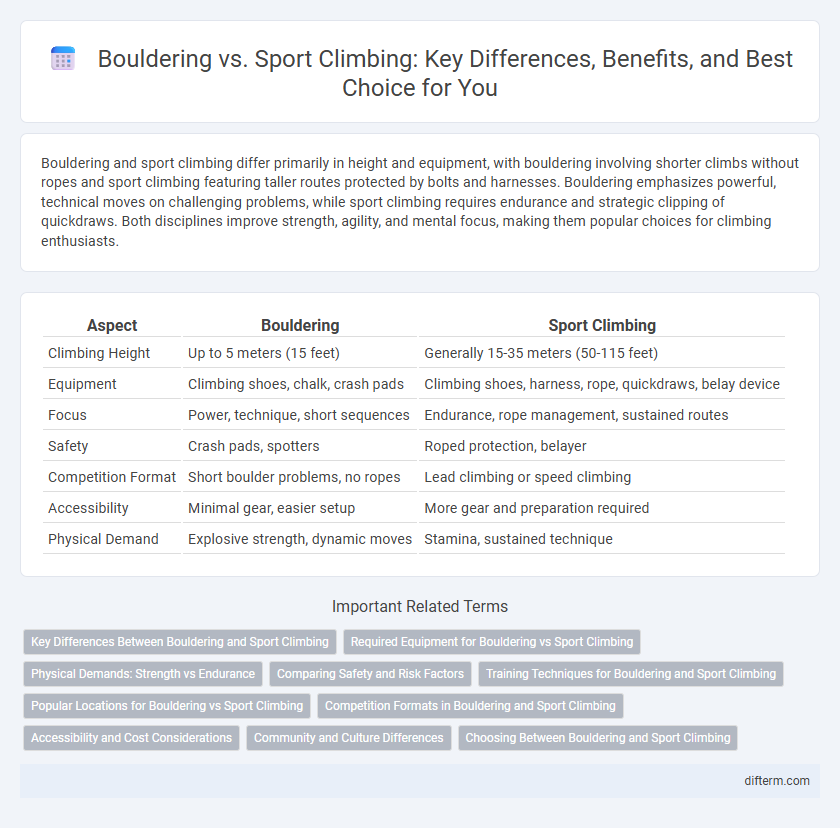Bouldering and sport climbing differ primarily in height and equipment, with bouldering involving shorter climbs without ropes and sport climbing featuring taller routes protected by bolts and harnesses. Bouldering emphasizes powerful, technical moves on challenging problems, while sport climbing requires endurance and strategic clipping of quickdraws. Both disciplines improve strength, agility, and mental focus, making them popular choices for climbing enthusiasts.
Table of Comparison
| Aspect | Bouldering | Sport Climbing |
|---|---|---|
| Climbing Height | Up to 5 meters (15 feet) | Generally 15-35 meters (50-115 feet) |
| Equipment | Climbing shoes, chalk, crash pads | Climbing shoes, harness, rope, quickdraws, belay device |
| Focus | Power, technique, short sequences | Endurance, rope management, sustained routes |
| Safety | Crash pads, spotters | Roped protection, belayer |
| Competition Format | Short boulder problems, no ropes | Lead climbing or speed climbing |
| Accessibility | Minimal gear, easier setup | More gear and preparation required |
| Physical Demand | Explosive strength, dynamic moves | Stamina, sustained technique |
Key Differences Between Bouldering and Sport Climbing
Bouldering involves climbing shorter routes called problems, typically under 15 feet, without ropes, emphasizing powerful, dynamic movements and technical precision. Sport climbing requires ascending taller walls or rock faces using ropes and fixed anchors, focusing on endurance, route reading, and safety systems. Key differences include the climbing height, use of protective equipment, and the physical demands, with bouldering prioritizing strength and power, while sport climbing emphasizes stamina and technique over longer sequences.
Required Equipment for Bouldering vs Sport Climbing
Bouldering requires minimal equipment, primarily climbing shoes, chalk, and crash pads for safety beneath short routes. Sport climbing demands more gear, including a harness, climbing rope, quickdraws, a belay device, and a helmet to manage higher pitches and secure protection points. The equipment differences reflect the contrasting risks and technical challenges inherent in each discipline.
Physical Demands: Strength vs Endurance
Bouldering emphasizes explosive strength and power, requiring climbers to execute short, intense bursts of movement on challenging routes typically under 20 feet high. Sport climbing demands greater endurance and stamina, as climbers ascend longer routes with sustained effort over 30 to 50 feet, relying heavily on aerobic capacity. Both disciplines develop distinct muscle groups and energy systems, with bouldering focusing on finger and upper body strength, while sport climbing enhances cardiovascular endurance and muscular fatigue resistance.
Comparing Safety and Risk Factors
Bouldering involves climbing shorter routes without ropes, increasing the risk of fall-related injuries despite padded mats, while sport climbing uses ropes and harnesses, significantly reducing fall severity through dynamic belaying systems. The risk factors in bouldering center around high-impact landings and overuse injuries in fingers and shoulders, whereas sport climbing presents risks related to anchor failure or improper belaying techniques. Safety in both disciplines depends heavily on proper equipment, technique, and adherence to established climbing protocols.
Training Techniques for Bouldering and Sport Climbing
Training techniques for bouldering emphasize short bursts of explosive power, finger strength, and dynamic movement drills to master complex problem-solving on overhanging walls. Sport climbing training prioritizes endurance, efficient footwork, and sustained grip strength through longer, continuous climbing sessions and route-specific practice. Incorporating hangboard exercises and campus board training benefits both disciplines by enhancing finger tendon durability and contact strength.
Popular Locations for Bouldering vs Sport Climbing
Bouldering thrives in locations like Hueco Tanks, Texas, and Fontainebleau, France, known for their short but challenging routes on natural rock formations. Sport climbing hotspots include Areas such as Siurana, Spain, and Kalymnos, Greece, offering bolted routes with varying difficulty that attract climbers globally. Many climbers choose destinations based on the terrain and type of climbing experience, balancing the intensity of bouldering with the endurance required for sport climbing.
Competition Formats in Bouldering and Sport Climbing
Competition formats in bouldering feature multiple short, high-intensity problems completed within a set time, emphasizing power and problem-solving skills. Sport climbing competitions involve athletes ascending longer, rope-protected routes aiming for maximum height or completion within time limits. Scoring in bouldering depends on the number of tops and attempts, while sport climbing rankings are based on the highest hold reached or fastest time in speed climbing variations.
Accessibility and Cost Considerations
Bouldering offers greater accessibility due to minimal equipment requirements, typically needing just climbing shoes and chalk, making it a cost-effective option for beginners. Sport climbing involves more gear, including ropes, harnesses, and protection devices, increasing initial expenses and complexity for newcomers. Indoor climbing gyms often provide bouldering walls at lower entry fees compared to full roped climbing setups, influencing budget-conscious athletes and casual participants.
Community and Culture Differences
Bouldering fosters a close-knit community centered around short, intense climbs and social problem-solving, promoting spontaneous collaboration and encouragement among climbers. Sport climbing culture emphasizes endurance and technique with longer routes, often creating a more individual-focused experience supported by structured training and competitions. Both disciplines share a passionate ethos but cultivate distinct social dynamics shaped by their unique challenges and environments.
Choosing Between Bouldering and Sport Climbing
Choosing between bouldering and sport climbing depends largely on personal goals and physical preferences, as bouldering emphasizes short, powerful routes typically climbed without ropes, while sport climbing involves longer routes with the use of ropes and protection. Climbers prioritizing strength and technique in intense, dynamic moves may prefer bouldering, whereas those seeking endurance, strategy, and mental focus over extended climbs often gravitate toward sport climbing. Equipment needs also differ, with bouldering requiring minimal gear like climbing shoes and crash pads, compared to the harnesses, ropes, and quickdraws essential for sport climbing.
Bouldering vs sport climbing Infographic

 difterm.com
difterm.com